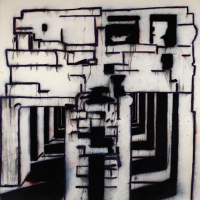39. TONY BEVAN

For more than four decades Tony Bevan has been creating works that combine a disarming simplicity with a great intensity, deeply personal explorations of the artistic psyche. Through a narrow range of subjects he delves over and over into the fundamentals of the creative process. His best-known works are the hundreds of self- portraits he has made, each one an attempt to find the essence of his own humanity. At times relatively conventional studies of the facial form, he will then dig deep below the surface to produce drawings that are part anatomical study, part ghost and utterly uncompromising in their search for an internal reality for his own existence. I dont really see the purpose of a self-portrait to just be a physical representation of the artist. What always interests me with self-portraits is the bit you dont see, looking up at the head from below almost up their nostrils. Then it becomes more about the bodiliness of the head, the structure and shape of it, which is more interesting for me and allows for more an entry into myself.1
Bevan has developed a style and technique that is all his own, a way of working that completely absorbs the artist into the fabric of the work. From a distance his works have a simple graphic quality, but on closer inspection there is a rich complexity of surface that speaks of the artists touch. His works are of a substantial scale, made on raw unstretched canvas laid directly on the floor. The surface is prepared by sprinkling pure pigments onto the canvas that the artist then rubs into the grain of the cloth. There is a natural organic feel to the canvas, like some ancient wall uncovered in Pompeii or the dirt floor of a colonial hut. He then draws directly onto the canvas with charcoal, a material he loves because of the unique form of every single piece. He presses and scrapes the surfaces, gradually building up form encased in broad lines and rich textures. When the design is complete he then works into the charcoal marks with pure powdered pigment, applied with the worn end of a coarse brush. The range of colour is small and always toward the earth tones ochres and umbers, rich reds and burnt sienna. Given the scale of the works he must bend and reach across the floor, walking on the canvas in old, thin-soled shoes that he keeps for just this purpose, wanting to feel the picture through his feet as much as through his hands. It is an intense and involving creative exercise, far removed from the cool discipline of, in Australian terms, a Jeffrey Smart (1921-2013) or a John Brack (1920-1999).
A Building with Two Corridors is one of a series of works exploring built structures as a metaphor for the human body and the mind. Bevan became fascinated with archives, both as buildings for holding information and for the information itself. He created designs based on the rows of shelves on which books and documents were arranged according to content and meaning. They were a simple metaphor for the human memory, the content of all the hundreds of self-portrait heads built up over the years. He saw the patterned repetition of books on shelves as a form of language in itself, a secret writing made up of the sum knowledge of human history. As well as a close view of the shelves and their content, Bevan also explored the depths of the buildings themselves, the dark corridors and blank walls between the rows, the building blocks required to bring order and reason to the chaos of human understanding. His building is a stylised human skull, with its two deep corridors, the eyes and paths to the memories and knowledge within. Tony Bevan has produced a stark view of the world that is at once universal, yet deeply personal, visually stark and elemental in its structure and human connection.
Footnote
1. Ellis-Petersen, H., 2014 Tony Bevan: Trees and Archives Organic, Geometric, and Human, The Guardian, 3 December 2014, accessed 27 November 2019
Gavin Fry BA[Hons] MA MPhil